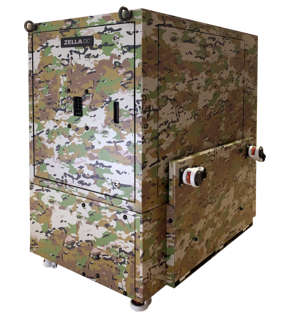Each business is unique and has different target customers, challenges, and goals. As a result, how you choose to set up your hardware and software should reflect that. Businesses have many alternatives when it comes to data storage and processing: cloud, data center, on-premise server room, micro data center, containerized data center, or even a hybrid set up including two or more of these.
Many businesses prefer to store all of their data (or at least some of it) on premise for various reasons. When your data is within your office, you have total control over both the hardware and software. Many managers want to know precisely how their equipment is handled; if you outsource to a third party you lose control.
Some companies choose on-premise data storage as they require very low latency to operate their systems or machinery. When your data is stored and processed where the action is, you can experience fewer delays and faster performance.
Micro data centers are increasingly becoming an attractive option for companies that want the control of an on-premises solution, but also want to reduce their expenses and improve their agility. When it comes to choosing between a traditional on-premises server room and a micro data center, which is suitable for your business? This will depend on your situation and priorities.
Let’s look at the different factors to take into consideration.
Space
On-prem server rooms take up valuable real estate for a business. While many companies start using a closet, it often turns into an entire room, or even an entire floor, as it grows. This space must be fitted for extra power and sealed and air conditioned to maintain an ideal temperature.
If you’re struggling to fit everything in your office, especially if your business, like many others, has downsized since the start of the Covid-19 pandemic, then a micro data center might be the right solution for you. They have a much smaller footprint, generally the size of an average fridge or vending machine, and don’t require a purpose-built environment.
Speed
The creation of a server room is a complex process that will involve many meetings and specialized technicians. From planning to construction, it can easily take months. You will need to set up racks, power, wiring, security, and cooling units, as well as ensure that the space is temperature-controlled and has fire-suppression equipment. Deploying a server room takes from the average company significant time and resources.
Many businesses don’t have the luxury of time. If you need to relocate in a hurry, or if your server room has stopped working, you will need to find an alternative solution quickly to minimize downtime. In this case you may want to consider a micro data center. Many micro data center manufacturers offer virtually plug-and-play solutions that can be shipped to you in a matter of weeks, and then set up in a matter of hours – you’ll be up and running in no time!
Cost
Server rooms are very expensive to build, run and maintain. In addition to high set up costs, there are high ongoing running costs, mostly caused by cooling and maintenance.
Micro data centers cost less for both deployment and maintenance. Their standardized designs offer easy maintenance and are less costly compared to on-premise deployments. They also save on utility costs compared to traditional on-premises solutions. They require much less energy to keep cool, and replacing parts is far easier than with conventional setups.
Carbon footprint
Along with the high energy bills, on-prem server rooms cost the environment. The energy it takes to maintain a room at an optimal temperature could seriously dent a company’s sustainability strategy.
A high carbon footprint can be damaging to brand reputation. More consumers are concerned with the impact of their purchases on the environment and are willing to turn to planet-friendly brands. Climate change and sustainability have become political factors that play a growing role in business management. There is more and more pressure for companies to limit their greenhouse gas emissions and to take action to become more environmentally friendly.
As micro data centers use less energy, they also have reduced carbon emissions.
Security
Security is a significant concern for businesses today. By ensuring that only staff members can access your data center, you can have the additional peace of mind that your equipment is in trustworthy hands. If you’ve converted a room into a server room, you need to make sure you set up access control to keep out any unauthorized personnel.
As micro data centers are self-contained, they are generally easier to monitor access. Plus, in many cases they already offer in-built security features.
Scalability
Upscaling a server room requires considerable commitment, not to mention money. Either that, or it’ll be necessary to plan from the outset a room large enough to be suitable for future needs – something not many companies have the budget or space to satisfy.
Micro data centers are modular, meaning you can add to them when necessary. Quite simply, they grow alongside your business needs. If your budget is tight you may choose to buy just one MDC and only add more if and when you require extra storage.
So far, we’ve mostly looked at situations where micro data centers are a preferable choice. So when is a server room the best option instead?
Number of racks
If you need more than about six-to-eight racks in the same location then micro data centers are not a viable solution and you’ll be better off building a traditional server room.
Existing server room
If you already have a server room and it’s working well then, by all means, keep it running! Migrating data and servers is time consuming and expensive so most businesses should not change their IT set up unless they absolutely have to.
External condenser
With most micro data centers, you’ll have to fit an external condenser on the outside of your building. If this is not possible for you (you may need to check with building’s owners), then a server room is the best option for you.
Low value
If your IT infrastructure is not too valuable and you are not too bothered by fire protection, security, extra cooling etc, you can probably get away with a simple set up like placing a few servers in a cupboard.
Whether you have a new business, or you’re relocating to new premises, make sure you take all these factors into considerations before choosing the best solution for your situation.




